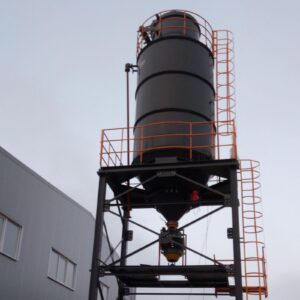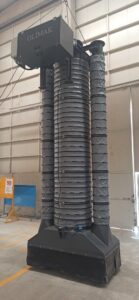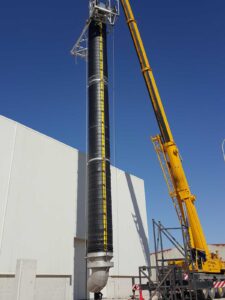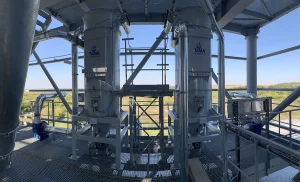Review
We offer a wide range of solutions for loading bulk materials. An important component in bulk materials handling processes, loading arms ensure dust-free and safe discharge of powdered and granular materials into trucks, tanks, ships and warehouses.


How do telescopic loaders (sleeves) work?
The basic idea of the loading arm system is to discharge powdered or granular bulk material through a vertical column under its own weight and collect the dust within this structure. The mechanical winch is controlled by a sensor to adjust the height while keeping the product loading area closed. Depending on the application requirements, the system may include various types of cones, dust collectors, sensors, ATEX version. There are two main types of telescopic sleeves: open and closed loading.


Telescopic sleeve for open loading
Telescopic open loading hose is used for filling open trucks, ships and warehouses. When loading begins, the hose is lowered onto the side of the truck/vessel or cellar and stops at the lowest point. The material falls freely through the inner cones. A flexible dust guard located on the underside of the hose keeps dust in the loading area. Additionally, it is possible to install or connect an aspiration filter to collect dust, which effectively prevents any dust emissions. Level sensors installed on the device are used to continuously monitor the product level. When the product level rises, the telescopic loader automatically rises. After loading is completed, the sleeve is retracted to the upper waiting position. Telescopic open loading hoses are available in a wide range of models and configurations depending on bulk material type, load capacity and application requirements.


Telescopic sleeve for closed loading
Telescopic sleeves for closed loading are used for filling tank trucks, barges and ships with closed containers. At the beginning of loading, the hose lowers and stops when it reaches the inlet of the tank. After this, the product supply begins. Material falls freely through the internal structure of the loader. The tank is filled with product. The air contained in the tank is returned through the structure and then removed through the air vent. A level sensor located at the cone discharge point monitors the product level in the tank and stops operation when the tank is full. Once loading is complete, the telescopic arm retracts to the upper standby position.
Advantages of telescopic loading arms
- Dust-free loading.
- Dust-free working area, preventing dust pollution, ensuring the safety of the plant and the environment.
- Suitable for various bulk materials transportation and storage systems.
- Loading is possible from various equipment such as silos, hoppers, screw feeders, conveyors, etc.
- Wide selection of models for a variety of needs.
- Auto lift function.
- No product waste.
- High temperature materials up to 300 C can be loaded.
- There are loading sleeves for food products.
- Easy to use.
- Easy to maintain.
Processed materials
Powder and granule materials such as cement, fly ash, rock minerals, calcium carbonate, plastic granules, plastic powders, polyethylene, ceramic powders, alumina, bentonite, bauxite, coal, cement clinker, gypsum, perlite, kaolin, limestone, marble powder, soda ash, quartz, urea, sodium sulfate, wheat, flour, animal feed, seeds, corn, rice, sugar, salt and similar powdered or granular solids.
Installation examples
Our projects



















